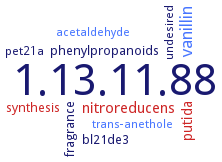1.13.11.88: isoeugenol monooxygenase
This is an abbreviated version!
For detailed information about isoeugenol monooxygenase, go to the full flat file.

Word Map on EC 1.13.11.88 
-
1.13.11.88
-
vanillin
-
nitroreducens
-
putida
-
phenylpropanoids
-
fragrance
-
synthesis
-
bl21de3
-
trans-anethole
-
acetaldehyde
-
pet21a
-
undesired
- 1.13.11.88
- vanillin
- nitroreducens
- putida
-
phenylpropanoids
-
fragrance
- synthesis
-
bl21de3
- trans-anethole
- acetaldehyde
-
pet21a
-
undesired
Reaction
Synonyms
iem, Iem720, ISO, NCED
ECTree
Advanced search results
Engineering
Engineering on EC 1.13.11.88 - isoeugenol monooxygenase
Please wait a moment until all data is loaded. This message will disappear when all data is loaded.
G398A
-
the mutation results in a 1.3fold increase in specific activity
H167A
mutation of conserved His residue, involved in binding of Fe2+. Loss of catalytic activity
H205A
mutation of conserved His residue, 6.8% residual catalytic activity
H218A
mutation of conserved His residue, involved in binding of Fe2+. Loss of catalytic activity
H282A
mutation of conserved His residue, involved in binding of Fe2+. Loss of catalytic activity
I352R
-
the mutant with 99.7% activity shows better thermostability than the wild type enzyme (70.4% residual activity after 15 min at 35°C)
K83R
-
the mutant with 103.9% activity shows better thermostability than the wild type enzyme (84.2% residual activity after 15 min at 35°C)
K83R/I352R
-
the mutant with 99.2% activity shows better thermostability than the wild type enzyme (87.8% residual activity after 15 min at 35°C)
K83R/K95R
-
the mutant with 104.8% activity shows better thermostability than the wild type enzyme (92.1% residual activity after 15 min at 35°C)
K83R/K95R/G398A
-
the mutant with 130.1% activity shows better thermostability than the wild type enzyme (94.1% residual activity after 15 min at 35°C)
K83R/K95R/I352R
-
the mutant with 114.3% activity shows better thermostability than the wild type enzyme (90.1% residual activity after 15 min at 35°C)
K83R/K95R/L273F
-
compared with the wild type enzyme, the thermal inactivation half-lives (t1/2) of the mutant at 25°C, 30°C, and 35°C increase 2.9fold, 11.9fold, and 24.7fold, respectively. Simultaneously, it also exhibits a 4.8fold increase in kcat, leading to a 1.2fold increase in catalytic efficiency. The tolerance of the mutant to metal ions is also improved
K95R
-
the mutant with 106.6% activity shows better thermostability than the wild type enzyme (68% residual activity after 15 min at 35°C)
L273F
-
the mutant exhibits 1.17fold increase in specific activity compared to the wild type enzyme
G398A
-
the mutation results in a 1.3fold increase in specific activity
-
I352R
-
the mutant with 99.7% activity shows better thermostability than the wild type enzyme (70.4% residual activity after 15 min at 35°C)
-
K83R
-
the mutant with 103.9% activity shows better thermostability than the wild type enzyme (84.2% residual activity after 15 min at 35°C)
-
K95R
-
the mutant with 106.6% activity shows better thermostability than the wild type enzyme (68% residual activity after 15 min at 35°C)
-
L273F
-
the mutant exhibits 1.17fold increase in specific activity compared to the wild type enzyme
-


 results (
results ( results (
results ( top
top






